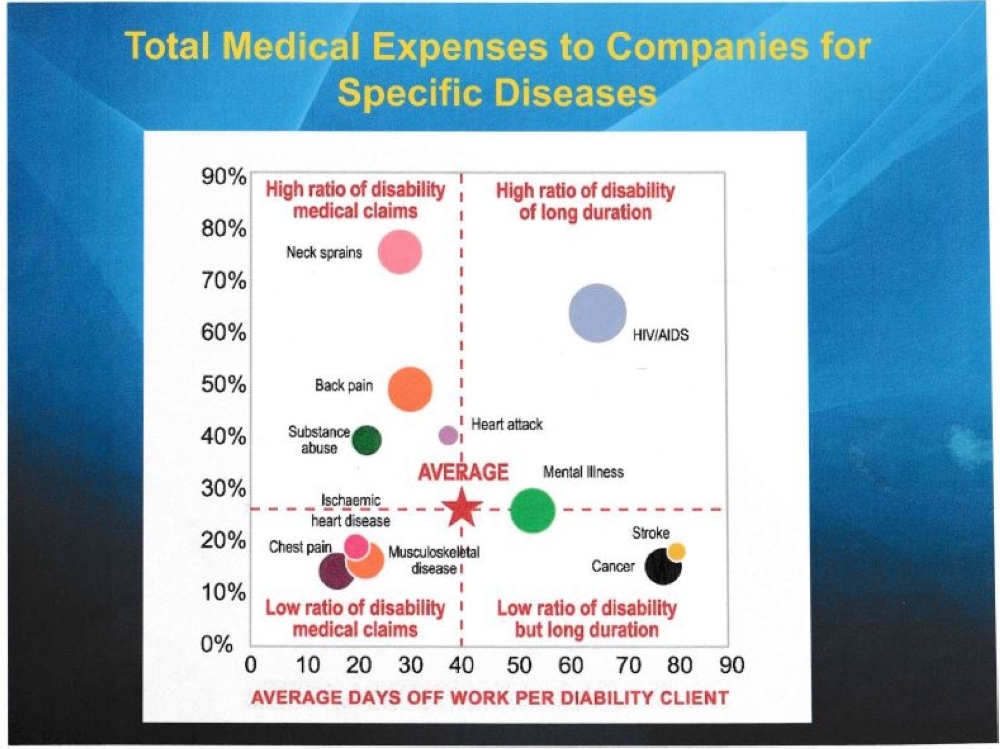Chronic pain: The Silent Epidemic
The combined cost of treating headaches, chronic back and neck pain exceeds the cost of treating all cancers.
Dr. C.M de Villiers (Spinal Orthopaedical Surgeon/Pain Interventionist) - Professor Gordon Waddell describes chronic pain as the 21 st Century’s worst medical disaster, with the combined cost of treating headaches, chronic back and neck pain exceeds the cost of treating all cancers. (See illustration)
Whv this exponential rise in chronic pain?
• Lifestyle: Patients sit in front of TV's, PC's and drive everywhere.
• Obesity: Fast foods have resulted that 35% of all American children with from 10 to 18 years old being obese.
• Lack of exercise: Fit, active people have a better coordination, balance, and muscle control.
• Habits: There is a direct link between smoking and spinal disc degeneration.
• What is the solution to this Silent Epidemic?
• Understand pain and its components.
• Act early to treat acute pain correctly, in less than two weeks.
• If your pain has lasted more than three months, consult a pain interventionalist to identify the source of the pain and to treat it correctly.
What is pain?
The International Society for the Study of Pain (ISSP) defines pain as "an unpleasant emotional experience which is associated with actual or potential tissue damage."
What are the six types of pain one can experience?
1. Nerve pain: due to direct pressure or cutting of a nerve i.e. sharp, severe shooting pain.
2. Vascular pain: a deep, constant dull ache, worse on exercise e.g., angina or hamstring tear i.e. due to ischaemia or trauma.
3. Bore or joint pain: a boring, deep ache i.e. toothache and becomes worse with movement e.g. fracture.
4. Visceral pain: spasmodic "colicky" pain with intervals of no pain between spasms. Severe nausea and sweating.
5. Neuropathic pain: i.e. chronic pain from an old nerve injury e.g. ghost pain of amputated limb or severe cancer pain due to cancer invasion of a nerve.
6. Atvpical pain syndromes: e.g., Multiple sclerosis, Fibromyalgia and Myalgia Encephalomyelitis (ME). These pain patterns are atypical and occur in patchy areas, worse if stressed or due to lack of sleep.
Pain Triage i.e., active early diagnosis and treatment of pain once one has established the type of pain pattern i.e. nerve, bone, or visceral pain. It is important to confirm the diagnosis and treat the patient aggressively to prevent the pain from becoming chronic i.e., lasting more than 3 months. Early intervention is critical to prevent chronicity, which leads to anxiety and depression due to the chronic pain.
Acute functional pain lasts less than six weeks and protects you from harm e.g., fractured arm by enforcing rest i.e. plaster cast. Chronic Non-Functional pain is a severe pain which lasts longer than three months. It is associated with lack of sleep, anxiety, and depression. - namibianpaincentres@gmail.
STATS:
Risk factors for chronic pain
• Genetics
• Obesity
• Age
• Previous injury
• Labour-intensive job
• Stress
• Smoking
Did you know?
Reduce
Current chronic pain treatments can reduce a person’s pain score by about 30%.
Health tip
Get enough sleep.
Health precaution tip
Manage your stress.
See a doctor when you experience sudden increase in the intensity of your current pain.
Whv this exponential rise in chronic pain?
• Lifestyle: Patients sit in front of TV's, PC's and drive everywhere.
• Obesity: Fast foods have resulted that 35% of all American children with from 10 to 18 years old being obese.
• Lack of exercise: Fit, active people have a better coordination, balance, and muscle control.
• Habits: There is a direct link between smoking and spinal disc degeneration.
• What is the solution to this Silent Epidemic?
• Understand pain and its components.
• Act early to treat acute pain correctly, in less than two weeks.
• If your pain has lasted more than three months, consult a pain interventionalist to identify the source of the pain and to treat it correctly.
What is pain?
The International Society for the Study of Pain (ISSP) defines pain as "an unpleasant emotional experience which is associated with actual or potential tissue damage."
What are the six types of pain one can experience?
1. Nerve pain: due to direct pressure or cutting of a nerve i.e. sharp, severe shooting pain.
2. Vascular pain: a deep, constant dull ache, worse on exercise e.g., angina or hamstring tear i.e. due to ischaemia or trauma.
3. Bore or joint pain: a boring, deep ache i.e. toothache and becomes worse with movement e.g. fracture.
4. Visceral pain: spasmodic "colicky" pain with intervals of no pain between spasms. Severe nausea and sweating.
5. Neuropathic pain: i.e. chronic pain from an old nerve injury e.g. ghost pain of amputated limb or severe cancer pain due to cancer invasion of a nerve.
6. Atvpical pain syndromes: e.g., Multiple sclerosis, Fibromyalgia and Myalgia Encephalomyelitis (ME). These pain patterns are atypical and occur in patchy areas, worse if stressed or due to lack of sleep.
Pain Triage i.e., active early diagnosis and treatment of pain once one has established the type of pain pattern i.e. nerve, bone, or visceral pain. It is important to confirm the diagnosis and treat the patient aggressively to prevent the pain from becoming chronic i.e., lasting more than 3 months. Early intervention is critical to prevent chronicity, which leads to anxiety and depression due to the chronic pain.
Acute functional pain lasts less than six weeks and protects you from harm e.g., fractured arm by enforcing rest i.e. plaster cast. Chronic Non-Functional pain is a severe pain which lasts longer than three months. It is associated with lack of sleep, anxiety, and depression. - namibianpaincentres@gmail.
STATS:
Risk factors for chronic pain
• Genetics
• Obesity
• Age
• Previous injury
• Labour-intensive job
• Stress
• Smoking
Did you know?
Reduce
Current chronic pain treatments can reduce a person’s pain score by about 30%.
Health tip
Get enough sleep.
Health precaution tip
Manage your stress.
See a doctor when you experience sudden increase in the intensity of your current pain.







Comments
Namibian Sun
No comments have been left on this article